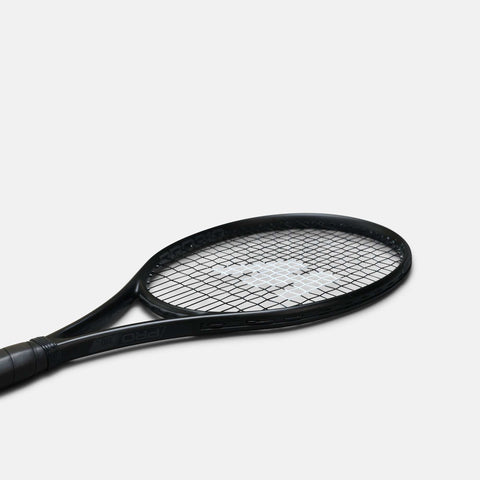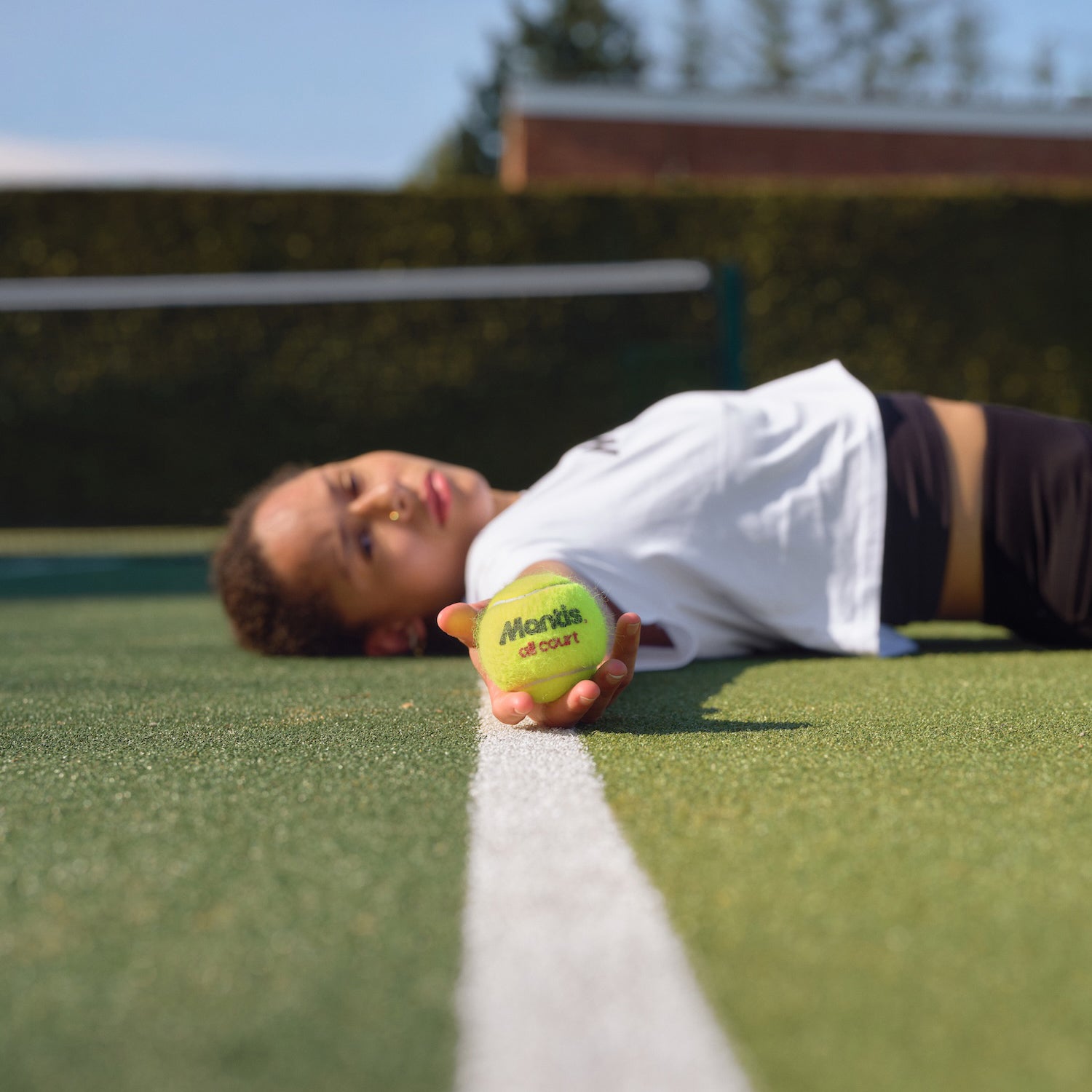
If you're seeking advice on how to choose a tennis racket we recommend that before you even look at a racket's specs, the first step in choosing the right one is to have an honest chat with yourself. Let’s move past vague labels like 'beginner' or 'intermediate'. They don't tell the whole story and can easily point you towards the wrong frame. The real question is: what kind of player are you today, and what are your genuine goals on the court?
Moving Beyond Basic Labels
Let's get practical when working out how to choose a tennis racket. How often do you really play? A player who enjoys a social hit on the weekend has completely different needs to someone training twice a week for league matches. Your stroke consistency is another massive piece of the puzzle. Do you have a well-developed, repeatable swing that creates its own pace, or are you still building your technique and need the racket to lend a helping hand? Being truthful here is the key to a smart purchase.

A common mistake is buying the same racket as your favourite pro, hoping it will sprinkle some of their magic onto your game. The reality is usually the opposite. Pro-level rackets are often heavier, less forgiving, and have a smaller sweet spot. They're built for elite athletes with flawless technique and incredible physical conditioning. Using one without the necessary skill can lead to frustration, poor shots, and even injuries.
Real-World Scenarios and Your Racket Choice
Think about where you are on your tennis journey and how that should guide your choice.
- From Social Player to League Competitor: You're stepping up from casual weekend games to your first local league. Your consistency is getting better, but you could still use some help with power and forgiveness when the pressure is on. A racket that blends both—perhaps a mid-plus head size with a slightly lighter weight—will support your game as it grows without harshly punishing your misses.
- Returning to Tennis After a Break: Maybe you played to a good standard years ago but are just getting back on court. Your muscle memory might be kicking in, but your timing and fitness probably aren't what they used to be. Don't immediately grab a demanding, control-focused racket. Start with something more forgiving to help you find your rhythm again and prevent arm fatigue.
This is where it helps to understand what's happening in the market. In the UK, while professionals inspire designs with their need for customised, heavy-duty frames, the biggest group of buyers is actually recreational players. For this majority, manufacturers rightly focus on lighter materials and larger heads, creating rackets that are easier to handle and more forgiving.
Weight and Balance: The Game-Changing Fundamentals
When you're trying to figure out how to choose a tennis racket, it's easy to get fixated on things like head size. However, the two factors that truly define how a racket feels in your hand are its weight and balance. These aren't just numbers on a spec sheet; they dictate your control, power, and how your arm feels after a tough three-setter. Getting this combination right is a massive step forward for your game.
There's a common myth that a heavier racket is always a more powerful racket. While a heavier frame (typically over 320g) offers more stability against pace and helps you plough through the ball, it requires excellent technique and physical strength. A classic mistake we see at the club is players choosing a racket that's too heavy for them. This slows down their swing, makes quick reactions at the net a struggle, and can even lead to fatigue or injury.
On the other hand, lighter rackets (around 250-290g) are much easier to swing. This helps developing players generate racket head speed, which is crucial for building a solid foundation with your strokes.
Head-Heavy vs. Head-Light: Where the Weight Sits
Beyond the total weight, its distribution—the balance point—completely changes how a racket plays. This is where we get into frames being either ‘head-heavy’ or ‘head-light’.
-
Head-Heavy Rackets: Most of the weight is loaded towards the top of the frame. This is common in lighter rackets and helps add a bit of punch and stability, especially for players who have a more compact swing. Think of it like a hammer—the weight in the head does a lot of the work for you. The trade-off is that it can feel a bit clumsy during fast exchanges at the net.
-
Head-Light Rackets: The weight is focused more towards the handle. This makes the racket feel much quicker and easier to swing fast, giving you fantastic control if you can generate your own power. This is why you’ll often see advanced players using head-light frames; it allows them to whip the racket through the ball for serious spin and pace.
Let's put this into a real-world scenario. Imagine a club player with a fairly flat, compact swing. They might struggle with a head-light racket because they can't create enough racket head speed to get depth on their shots. They would probably feel more comfortable with a slightly heavier, more evenly balanced frame that gives them some easy stability and pop.
Now, think about a junior player with quick hands who loves to attack and move forward. They would feel held back by a clunky, head-heavy racket. A head-light model would suit their aggressive style perfectly, allowing them to react fast and be creative. The goal is to match the racket's specs to your current physical ability and playing style, not the player you hope to be in a year's time.

Head Size Decoded: Power Versus Control Reality Check
Once you've considered weight and balance on your quest for information on how to choose a tennis racket, you'll run into the age-old debate about head size. It's usually presented as a straightforward choice: go bigger for power, smaller for control. While there's some truth to this, the right racket for you has much more to do with your personal technique than any marketing slogan. Let's dig into how head size genuinely impacts your game during a real match.
Bigger Isn't Always Better
A larger head size, generally 100 square inches or more, creates a bigger sweet spot. This is the prime area on the string bed that delivers the best response and feels the most comfortable on contact. For players with more compact swings or those still refining their technique, this larger target can be a massive confidence booster. It offers more "free" power because the string bed deflects more at impact, launching the ball with greater speed—think of it as a trampoline effect.
But a larger head can feel clumsy for serves and volleys where quick manoeuvrability is essential. We've seen plenty of players switch to an oversized frame hoping for more forgiveness, only to discover their net game feels sluggish and their serves lose precision. It's a classic example of fixing one problem while creating another.
When Smaller Makes Sense
Rackets with a smaller head size, typically under 100 square inches, are built for players who generate their own power with a full, fast swing. These frames provide superior control and feel because the tighter string bed deforms less, giving you a more direct and predictable response. If your technique is solid and you consistently hit the middle of the strings, a smaller head will reward you with pinpoint accuracy on your groundstrokes and serves.
A player we've seen coached, who has a big, flowing forehand, recently switched from a 102 to a 98-square-inch frame. He immediately noticed his shots were landing deeper and with more purpose. His confidence shot up because the racket was now complementing his natural swing, not fighting against it.
To help you visualise the differences, here’s a quick guide comparing various head size categories and what they offer.
Tennis Racket Head Size Comparison Guide
Comprehensive comparison of different head sizes showing ideal player types, advantages, and typical specifications
| Head Size Category | Square Inches | Best For | Power Level | Control Level | Forgiveness |
|---|---|---|---|---|---|
| Oversize | 105 sq. in. + | Beginners, players with short, compact swings, or those needing extra power. | High | Low | High |
| Midplus | 98-104 sq. in. | A wide range of players, from intermediate to advanced. Offers a blend of power and control. | Medium | Medium | Medium |
| Midsize | 97 sq. in. & below | Advanced players with long, fast swings who generate their own power and prioritise control. | Low | High | Low |
This table shows that while a larger head offers more forgiveness, it comes at the cost of control. Your choice depends on whether you need the racket to provide power or to tame the power you already have.
Your ideal head size is the one that synchronises with your natural swing style and shot-making confidence, not just a generic recommendation from a chart.
String Patterns and Tension: The Hidden Performance Multipliers
It’s a common sight at any tennis club: players obsess over every detail of a racket’s frame but completely overlook the one part that actually touches the ball—the strings. This is a huge oversight, because the string pattern and tension are the real engine of your racket. Getting this combination right is a crucial step when you're learning how to choose a tennis racket, as it can transform an average frame into your perfect partner on the court.
String Pattern: The Spin vs. Control Trade-Off
The string pattern simply refers to the number of main (vertical) and cross (horizontal) strings. But don't let its simplicity fool you when you're researching how to choose a tennis racket; this grid has a massive effect on how the ball behaves when it leaves your racket.
-
Open Patterns (e.g., 16x19): With fewer strings and larger gaps between them, the strings can move more freely and "bite" into the ball, generating a lot more spin. You'll also notice the ball sinking deeper into the string bed, a sensation known as ball pocketing. This creates a higher launch angle and a powerful, lively response. The only real downside? All that movement leads to more friction, meaning strings tend to break more often.
-
Dense Patterns (e.g., 18x20): By packing more strings into the same area, this pattern feels much firmer and more controlled. The strings don't move as much on impact, giving you a more direct and predictable response. If you're a flat hitter who values precision above all else, a dense pattern can feel incredible. However, it offers less "free" spin and can feel less powerful if you don't generate your own pace.
Finding Your Ideal Tension
String tension, measured in pounds (lbs) or kilograms (kg), is where you can truly fine-tune your racket’s feel and performance. While manufacturers provide a recommended range, your personal sweet spot is something you'll discover over time.
-
Lower Tension: This setup gives you more power and comfort. Think of the strings as a trampoline; a looser bed catapults the ball off the racket face. It’s also much easier on the arm, a key factor for anyone worried about tennis elbow.
-
Higher Tension: This offers superior control and is often preferred by advanced players who swing fast and create their own power. Tighter strings reduce ball pocketing, resulting in a very direct and precise feel on contact.
The best way to find your perfect setup is simply to experiment. Start at the midpoint of your racket's recommended range. If you want more pop, try restringing it 2-3 pounds lower and see how it feels. A small adjustment can make a world of difference to your shots and your arm's health. Smart string choices can make a good racket great, but poor ones can make even the most premium equipment a disappointment.
Frame Materials: Beyond the Marketing Jargon
Nearing the end of your quest for help on how to choose a tennis racket and once you've narrowed down the core specs like weight, head size, and string pattern, the final piece of the puzzle is the material used to build the racket frame. Every brand loves to talk about their special blend of graphite, titanium, or other composites, but what does all that technical speak actually mean for your game on a Sunday afternoon? The truth is, the material composition has a direct effect on the racket's feel, stiffness, and how long it will last.
Stiffness: The Real Story on Power and Comfort
One of the biggest factors determined by frame materials is stiffness, which you'll often see measured as an 'RA' rating. A stiffer frame (with a higher RA) bends less when you hit the ball. This means less energy gets lost in the frame, and more power is sent straight to your shot. However, this power comes with a trade-off: a stiffer frame also passes more shock and vibration up to your arm, which can be a real problem for players with a history of elbow or shoulder issues.
On the other hand, a more flexible frame (with a lower RA) bends more on impact, absorbing much more of the shock. This creates a more comfortable, arm-friendly feel and what many players describe as better 'ball pocketing'. While you might get a little less raw power, the extra control and comfort are often a worthy exchange for club players. Finding that sweet spot is a key part of choosing a tennis racket that supports your long-term health and enjoyment on the court.
Are Premium Materials Worth the Price?
Modern racket manufacturing has advanced significantly, and you can now find high-quality graphite constructions at nearly every price point. Premium rackets often mix graphite with materials like basalt, tungsten, or graphene to fine-tune stability and reduce vibrations without adding a lot of weight. For a closer look at these innovations, you can learn more about Mantis racket technology and see how specific material arrangements are engineered for performance.
Ultimately, the goal is to find a material blend that feels right for your playing style. This focus on performance through technology has really pushed the market forward. In fact, the UK Tennis Rackets market grew to a value of approximately $60million in 2024, largely because these technical improvements have boosted power, control, and injury prevention for players at all levels. A more expensive racket isn’t automatically better; the right one is the frame that feels like an extension of your own arm.

Smart Shopping: Navigating the Modern Racket Marketplace
Knowing which racket specifications suit your game is a huge win, but the journey isn't over yet. The final piece of the puzzle is figuring out where to buy your new frame. You're faced with a choice: the hands-on expertise of a specialist tennis shop or the vast selection and competitive pricing of online retailers. Becoming a savvy shopper ensures you not only get the right racket but also a fair deal.
Specialist Shops vs. Online Retailers
There’s an undeniable advantage to walking into a dedicated tennis shop: human expertise. A good shop assistant can be your most valuable asset, talking you through different models and explaining how they feel in your hand. Most importantly, many offer a demo programme just like we offer at Mantis with all our rackets having a 10 day demo offer. This is your golden ticket—a chance to take a few shortlisted rackets onto the court for a proper hit. This experience is something you just can't get from a screen.
However, you need to be able to tell genuine advice from a hard sales pitch. The best way to do this is by asking smart, specific questions:
- "You've suggested this head-light racket. Can you explain why that balance would suit my game better than this evenly balanced one?"
- "How will the stiffness rating on this frame affect my comfort, especially since I've had some arm tenderness before?"
- "If I go with this racket, what string and tension would you recommend to get the most out of it for my style of play?"
A true professional will give you detailed, personalised answers. If their only response is to guide you towards the priciest model on the wall without a good reason, it’s probably a sign to be cautious.
Of course, the rise of online shopping has completely changed how we buy our gear. The UK's racket sports market is booming, projected to hit around US$97.98 million in revenue by 2025 and if these figures from the United States Tennis Association are correct then the World's biggest tennis playing country is also enjoying a bumper time. A massive driver of this is online sales, with an expected annual growth of 8.2% for tennis equipment between 2025 and 2035. Players are increasingly relying on detailed specs and reviews to make their choice.
While online stores offer incredible prices and a near-endless selection, you sacrifice that crucial hands-on feel. Our advice? If you’re buying online, either make sure you've demoed the racket somewhere first or you're simply upgrading to the newest version of a frame you already know and love. And always, always check the returns policy before you click "buy".
To help you decide which path is right for you, here’s a breakdown of your options.
Tennis Racket Buying Options Comparison
| Purchase Channel | Advantages | Disadvantages |
|---|---|---|
| Specialist Tennis Shop | Expert advice, demo programmes, immediate purchase, professional stringing services. | Higher prices, smaller selection, potential for sales pressure. |
| Large Online Retailer | Huge selection, competitive prices, customer reviews, convenience. | No hands-on feel, can't demo, returns can be a hassle, impersonal. |
| Second-Hand Market | Very low prices, opportunity to find rare or older models. | No warranty, unknown condition (cracks, wear), no returns. |
| Direct from Brand | Access to the latest models, brand-specific deals, guaranteed authenticity. | Prices are often full retail, limited to one brand's ecosystem. |
This table shows there’s no single "best" place to buy a racket. Your ideal choice depends on your confidence, your budget, and whether you need to test the frame first.
Finding Value and Avoiding Pitfalls
Whether you're browsing in a shop or scrolling online, always be on the lookout for a good deal. End-of-season sales are fantastic for snagging last year's top models at a significant discount. Often, the only difference between this year's and last year's racket is a fresh coat of paint. Some shops also run trade-in programmes, which can be a great way to put your old frame towards the cost of a new one.
Ultimately, the goal is to make a purchase you feel confident about. The smartest approach is often a hybrid one: use the expertise and demo programmes of a local shop to find the perfect racket, then use your online research skills to find the best possible price. This combination gives you the best of both worlds, helping you land a racket that fits your game, your arm, and your budget perfectly.
Your Personal Racket Selection Blueprint
It’s time to bring everything together from your research into how to choose a tennis racket. With so many variables, choosing a tennis racket can feel a bit like spinning plates, but you can avoid analysis paralysis by creating a clear, personalised plan. This isn't about chasing a mythical "perfect" racket; it's about finding the best possible match for your game right now. The trick is to prioritise what's truly important for you, rather than trying to tick every single specification box at once.
Creating Your Decision Framework For How to Choose a Tennis Racket
Your framework needs to be built on an honest assessment of your game. Let's imagine two simple, practical scenarios to help guide your thinking.
-
Scenario A: The Consistency Seeker: You're a club player whose main goal is simply to get more balls back in play and cut down on unforced errors. Your top priorities should be forgiveness and comfort. This means you'll focus on rackets with a head size of 100 sq. inches or larger, a medium weight (290-310g), and a more flexible frame (a lower RA rating) to be kind to your arm. Power is less of a concern because you’re building it through better technique, not relying on your equipment.
-
Scenario B: The Aspiring Attacker: You already have a reliable swing and want to start dictating points with more power and spin. Here, your priorities shift to control and manoeuvrability. You should look for rackets with a head size under 100 sq. inches, a denser string pattern (18x20), and a head-light balance. You're trading a bit of forgiveness for the pinpoint precision needed to hit your targets with confidence.
Testing and Making Your Final Choice
Once you’ve identified your priorities in your search for advice on how to find a tennis racket, the demo process becomes much clearer. Don’t just hit a few balls; try to play actual points. Can you serve consistently for an entire set? Do you feel confident stepping in for a volley? Pay close attention to how your arm feels after an hour of play. A racket that feels incredible for ten minutes might reveal its drawbacks during a longer session.
Don't forget to select the right grip size, as this has a massive impact on both comfort and control. You can learn more about finding your perfect fit in our guide to tennis racket grip sizes.
Choosing the right racket is a journey of self-discovery. By following a clear blueprint, you can confidently select the frame that will feel like an extension of your arm on the court.
How to choose a tennis racket that matches your ambition? Explore the Mantis collection, crafted with precision for dedicated players.








